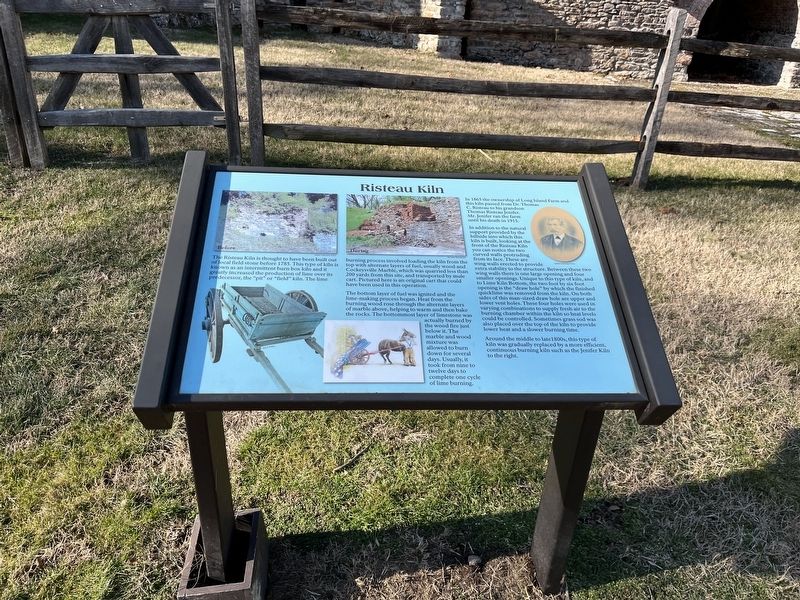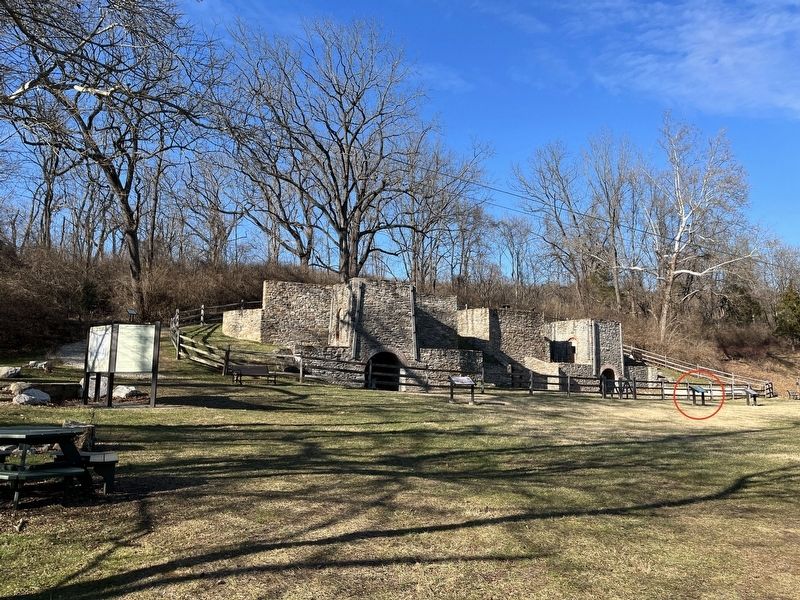Cromwell Valley in Parkville in Baltimore County, Maryland — The American Northeast (Mid-Atlantic)
Risteau Kiln
The bottom layer of fuel was ignited and the lime-making process began. Heat from the burning wood rose through alternate layers of marble above, helping to warm and then bake the rocks. The bottommost layer of limestone was actually burned by the wood fire just below it. The marble and wood mixture was allowed to burn down for several days. Usually, it took from nine to twelve days to complete one cycle of lime burning.
In 1865 the ownership of Long Island Farm and this kiln passed from Dr. Thomas C. Risteau to his grandson Thomas Ristaeu Jenifer. Mr. Jenifer ran the farm until his death in 1915.
In addition to the natural support provided by the hillside into which this kiln is built, looking at the front of the Risteau Kiln you can notice the two curved walls protruding from its face. These are wing walls erected to provide extra stability to the structure. Between these two wing walls there is one large opening and four smaller openings. Unique to this type of kiln, and to Lime Kiln Bottom, the two foot by six foot opening is the "draw hole" by which the finished quicklime was removed from the kiln. On both sides of this man-sized draw hole are upper and lower vent holes. These four holes were used in varying combinations to supply fresh air to the burning chamber within the kiln so heat levels could be controlled. Sometimes grass sod was also placed over the top of the kiln to provide lower heat and a slower burning time.
Around the middle to late 1880s, this type of kiln was gradually replaced by a more efficient, continuous burning kiln such as the Jenifer Kiln to the right.
Topics. This historical marker is listed in these topic lists: Industry & Commerce • Parks & Recreational Areas • Settlements & Settlers. A significant historical year for this entry is 1785.
Location. 39° 25.085′ N, 76° 32.665′ W. Marker is in Parkville, Maryland, in Baltimore County. It is in Cromwell Valley. Marker can be reached from Cromwell Bridge Road. Touch for map. Marker is at or near this postal address: 2200 Cromwell Bridge Rd, Parkville MD 21234, United States of America. Touch for directions.
Other nearby markers. At least 8 other markers are within 3 miles of this marker, measured as the crow flies. Jenifer Kiln (a few steps from this marker); Shanklin Kiln (a few steps from this marker); Risteau Lime Kiln (a few steps from this marker); Jenifer Lime Kiln (a few steps from this marker); Merrick Log House (within shouting distance of this marker); The Balancing Reservoir (approx. 0.2 miles away); Knettishall (approx. 2.2 miles away); Thoroughbreds at Hampton (approx. 2.2 miles away). Touch for a list and map of all markers in Parkville.
Credits. This page was last revised on March 25, 2023. It was originally submitted on March 21, 2023, by Adam Margolis of Mission Viejo, California. This page has been viewed 55 times since then and 5 times this year. Photos: 1, 2. submitted on March 21, 2023, by Adam Margolis of Mission Viejo, California. • Bill Pfingsten was the editor who published this page.

